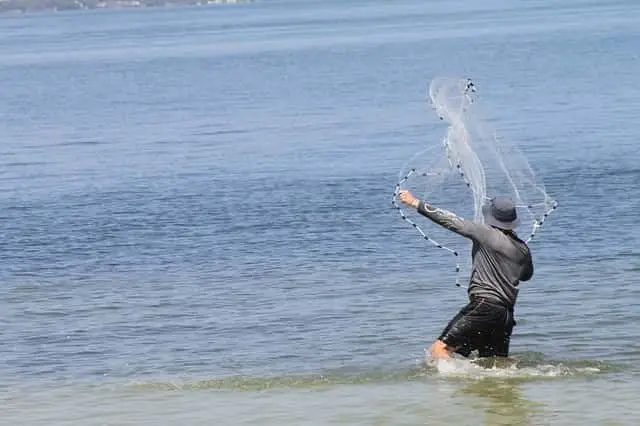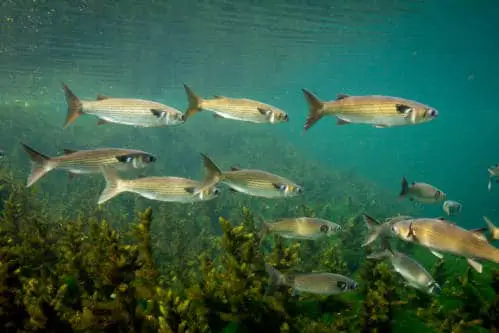Cast nets are convenient for bagging baitfish in numbers, especially schooling fish like mullet.
And if you’ve ever eaten smoked mullet and grits, you’ll know a cast net is the best way to fill a cooler before a cookout!
In this article, I’ll share everything you need to know to cast net for mullet, including tips, cast net types, rules, and frequently asked questions.
This post may contain affiliate links. As an Amazon Associate, I earn from qualifying purchases
Table of Contents
- How Do You Cast Net for Mullet?
- What Is the Best Cast Net for Mullet?
- What Size Cast Net for Mullet?
- Cast Net Regulations for Mullet
- Final Thoughts
How Do You Cast Net for Mullet?
To cast net for mullet, first select the appropriate mesh size for the mullet you are trying to catch. Plan your approach carefully, whether on foot or in a boat, with the sun to your back, and remain quiet. Throw your net over the school of fish, and allow it to sink to the bottom before retrieving.
The key to being successful when cast-netting for mullet is being able to throw a net efficiently and perfectly each time.

That means throwing a perfect circle or ‘pancake’ which allows the net to open to the full diameter, and maximizes your catch area.
This can easily be achieved with practice! In fact, when I learned to throw a cast net I simply practiced on empty cans in my yard. Fluffy grass and old pepsi cans work great as targets!
Do some scouting in your area to find where mullet congregate. This is often is shallow muddy flats, estuaries or on the edges of coastlines, sandbars and inlets.
Plan your approach carefully and quietly. Mullet can spook easily, and your first throw will always be your best chance before the school becomes scattered.
What Is the Best Cast Net for Mullet?
For full-size mullet, an 8-10 foot net with 1-inch mesh is best. For finger mullet, a 6-8 foot net with 3/8-inch mesh is best.
But more important than the cast net size, is the user capability. It does no good to throw a 12-foot net if it’s too heavy and you’re unable to throw it effectively.
Always choose a net size, and weight that you can comfortably and confidently throw each time.
The Brail Net
This is your regular and most common cast net that comes with a number of brail lines that run from the lead line to a central ring called the yoke. The yoke connects them to the pulling rope called a hand line and turns the entire net into a holding bag.
These are most likely crafted from monofilament. A brail net needs the same care you give to your monos. After every use, they should be rinsed, ensuring no residue is stuck in the mesh.
Allow the cast net to dry and store it in a dry environment (avoid letting the lead line hang off the ground when you hang them to dry). Exposure to the sun should be limited, and the net should be inspected regularly so that any tears and cuts are mended.
No single cast net is primed for all targets and conditions. Multiple variables come into play when cast netting mullet, which will determine your net’s effectiveness and should be considered.
There is a viable cast net for different sizes of mullet, the depth you will be fishing, different weather conditions, and individual throwing skill levels and strengths.
The Mesh Size
The mesh should be large enough to let small fish through yet small enough to fit the head of your target mullet.
For instance, a 1 1/2-inch cast net, while effective for mature mullet, is too big for finger mullet, and they will either escape through the mesh or get uncomfortably gilled and trapped. The agitation tires them, reducing their effectiveness as bait and even increases their mortality rate.
The size of the mesh also influences the rate at which the net sinks. Small mesh cast nets take longer to sink than larger mesh sizes.
Weight of the Cast Net
The other variable that affects the sink rate is the weight of the cast net, and this is a factor of line density, the size of the net, and lead weight per foot of radius.
The heavier it is, the faster it sinks; a fast sink rate reduces the mullets’ window of escape under the falling net and is ideal for deepwater applications.
A hefty cast net requires more strength and skill to throw, and you shouldn’t go beyond your manageable weight.
Cast Net Material
The makeup of the net also impacts its effectiveness when catching mullet. The most common cast net materials are monofilament and nylon.
- Nylon is light, has no memory, and is also limp, making it less likely to injure the fish. It collapses on itself and is easier to store. However, it gets heavier when wet, making the net harder to cast.
- Monofilament is less malleable and will occupy more space. It, however, gets fewer tangles, has low drag in the water, and is easier to clean up. It is also less visible to the mullet and sinks faster, making it the better option for a mullet cast net.
What Size Cast Net for Mullet?
The net size is measured by its overall length while closed. An 8-foot net has a radius of 8 feet and a diameter of 16 feet.
Small nets (6 feet or less) are light and will open fully with less effort, making them great for beginners, and you can throw them longer before fatigue sets in.
It, however, makes more sense to cast a large net at a school of baitfish because you get to maximize it, netting more fish on a single throw.

The easily spooked mullet won’t stick around to offer you a second shot. This is why you should opt for the largest net you can confidently throw.
And don’t worry, it doesn’t have to be a 10-foot net! I catch a ton of bait with a simply 5 foot Bett’s cast net.
Remember, a compromised throw with a large net can be less effective than a flawless pancake with a smaller cast net.
Get a net that you will be able to throw, considering you might have to cast it several times.
To provide perspective, a 3-foot radius cast net should weigh between four and five pounds depending on the type of line used, while a 14- foot radius net weighs upwards of 20 pounds!
Mesh size is measured in square mesh units representing the distance from one knot to the other.
Select the largest mesh size possible that won’t gill your target mullet size.
- 3/16” or 1/4” cast nets accommodate 1 to 3-inch baitfish and are good for small fish like minnows or shrimp.
- 3/8”, 1/2”, or 5/8” nets are good for regular-sized baitfish, 3 to 10 inches long like ballyhoo, menhaden, pinfish, threadfin, scaled sardine, or finger mullet.
- 1 to 1 1/2” size mesh will suit large baitfish, 12 inches and beyond, ideal for adult mullet (yum, fire up the smoker!)
What Size Cast Net For Finger Mullet?
The most common size cast net for finger mullet is a 6 to 8 foot net with a 3/8″ mesh size. This allows for a 12-16 foot radius, and can easily capture finger mullet from 3 to 6 inches…the perfect size for bait!
Cast Net Regulations for Mullet
Cast netting for mullet is regulated by cast net regulations, mullet fishing regulations, and general fishing regulations. Some of the regulations are federal, while others are unique to the states where they are applied, although they often overlap.
Check with your state fishing regulatory agency and start by confirming whether it is even legal to use a cast net to catch mullet and if it is, the largest size of net you can use.
For example, Florida’s Fish and Wildlife Conservation Commission (FWC) allows a maximum length of 14 feet per cast net and a maximum of 2 cast nets per vessel.
In Alabama, cast nets shouldn’t be more than 30 feet in diameter and must be hand thrown going by these directives of the Alabama Department of Conservation and Natural Resources.
There are also bag and creel limits regulating the number of mullet you can fish simultaneously per species. These vary depending on the state or county, and you should familiarize yourself with local regulations before you set out to cast net for mullet.
Some of these rules are applied differently depending on whether you are fishing for commercial or recreational purposes. The regulations may also vary with seasons as they are designed to maintain the ecosystem.
Final Thoughts
Once you learn how to cast net for mullet, you’ll be on your way to catching more fish. Not only can you catch bait (and save money), but you can also catch other fish and increase your likelihood of coming home with a meal.
Don’t be intimidated by the process…pick up an inexpensive cast net and start practicing in your yard.
Watch a couple of videos, and you’ll be throwing pancakes and netting mullet in no time!

Growing up in Florida, I’ve been surrounded by saltwater my entire life…and I love sharing my passion with others.
To learn more about why I started Saltwater Mecca, visit the ABOUT page.
Thank you for reading this article. Browse around & have some fun!